Fig. 8.1
After a periodontal session, a topic fluoride gel is applied on the teeth surface
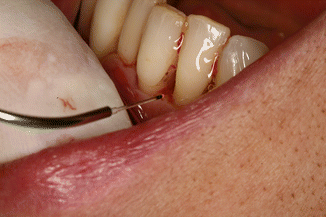
Fig. 8.2
Defocused and scanning mode
Chronic hypersensitivity requires a follow-up visit after 6 months, possibly including another desensitizing laser session at time, due to the transient period of desensitizing action. Laser settings suggested from the author are commonly very low and safe and enable a gentle heating of the irradiated surface, the precipitation of the K and F ions, and a minimal thermal interaction of the wavelength with the dentin; as a result, dentin tubule orifices are closed through an organic–inorganic melting including the K and F ions.
Diode laser setting is 0.4 W in continuous wave with a non-activated 400-μm fiber.
Nd:YAG laser setting is 0.75 W, 15 Hz, always with a non-activated 400-μm fiber.
Er:YAG and Er,Cr:YSGG are used at 25 mJ, 10 Hz, with a 600-μm tip and with water spray off and air spray on.
8.2 Deep Dentinal Caries
As previously discussed (see Sects. 7.5.1, 7.5.2, and 7.5.3), treatment of the deep dentin at the completion of cavity preparation is an important step for maintaining the pulp vitality.
The identification and removal of the deeper layers of caries are clinically subjective to perform, and concern about the survival of microorganisms in deep carious lesions may often lead to unnecessary over-excavation in healthy dentin, with exposure of the pulp during complete caries excavation [24].
To minimize this risk, conservative caries removal techniques have been proposed, including indirect pulp capping, partial removal, and stepwise excavation [25, 26]. The differences and borders among these techniques are minimal.
Indirect pulp capping is defined by Ingle as a procedure where a small amount of carious dentin is retained in deep cavity to avoid exposure of pulp, followed by the application of calcium hydroxide on the deep carious dentin in proximity to the pulp in order to stimulate the formation of reparative dentin [27].
Lately, also new technologies, including among the other, chemomechanical preparation and laser, have been investigated for this purpose [4, 28].
8.2.1 Carious Removal Rationale
Different caries removal techniques have been proposed to challenge the doctrine of complete caries removal. The rationale of these techniques considers the composition and changes of carious dentin, the decrease of bacteria load during excavation, and the formation of the tertiary dentin.
Carious dentin consists of two main distinct layers:
-
An outside layer that is irreversibly denatured and infected; it is not remineralizable and should be removed.
-
An inside layer that is reversibly denatured, not infected, and remineralizable and should be preserved.
Deep dentin treatment is focused on changing an active lesion into a less active or arrested lesion, even without performing an excavation close to the pulp [29], thus promoting the pulpo-dentinal complex to form tertiary dentin [30].
However, it must be emphasized that the final excavation step of the less softened dentin closer to the chamber roof is critical.
8.2.2 Indication
When a patient has negative history for pain, a tooth has no clinical symptoms, if not a transient pain shortly before treatment, and the intraoral radiograph reveals carious lesions to such a depth that a complete removal of caries would probably cause a pulp exposure, a stepwise excavation or an indirect pulp capping may be suggested.
In a clinical–microbiological study, the stepwise excavation technique was carried out on several patients with deep caries and negative history for pain; the outer layer of carious dentin was found typically orange colored; 6 months after excavation, a calcium hydroxide-based medication, and ZOE temporary filling, the dentin color changed to dark brown in the central inner layer when starting the second session, to finally resemble the color of the completely excavated peripheral dentin at the end of the excavation [24, 31]. Also the consistency of dentin changed, with enhanced hardness of the dentin, associated with a marked reduction in bacterial growth after the final excavation; the study suggested that the initial removal of the cariogenic biomass appears to be essential for control of caries progression [24]. At the second excavation, both stepwise excavation and partial carious tissue removal presented lower pulp exposure rates and higher success rates than complete carious removal [24, 32–34].
Several clinical trials have demonstrated the benefits of incomplete caries removal, in particular in the treatment of deep caries, and based on the reviewed studies, incomplete caries removal seems advantageous compared with complete excavation, when in proximity to the pulp, also leading to a reduced need for the direct pulp capping [32–36]. However, there is no consensus in the literature about which is the better technique [37], being the main difficulty, to understand when the excavation must be stop.
8.2.3 Laser Treatment of Deep Dentin
All the laser wavelengths allow for deep decontamination in the outer and inner dentin layers [38], but it is the full cavity preparation performed with the erbium family lasers that offers several advantages [4, 39, 40] that can play a fundamental role in the treatment of deep dentin caries, as specifically reported in Table 8.1.
Table 8.1
Erbium laser advantages in deep dentin treatment
|
Advantages
|
Hazards
|
|---|---|
|
Selective carious dentin removal, saving more healthy dentin to be ablated
|
Operative hazard
|
|
Deep decontamination of the irradiated surface
|
Microbiological hazard
|
|
Clean surface and reduced possibility of dislodging infected dentin chips into the pulp
|
Microbiological hazard
|
|
Reduced heating of the pulp during laser cavity preparation
|
Physical hazard
|
Using the erbium lasers, whether the choice is an indirect pulp capping or stepwise excavation or complete caries excavation, the laser-assisted technique makes the procedure much more predictable, as the erbium lasers are more selective for carious tissue (see Sect. 7.5), thus allowing complete caries vaporization while preventing possible unwanted pulp exposure and detoxifying the surface up to 300–500 μm [41, 42] (see Sects. 7.5.1 and 7.5.3), so ensuring a deeper decontamination in dentin (Figs. 8.3 and 8.4).
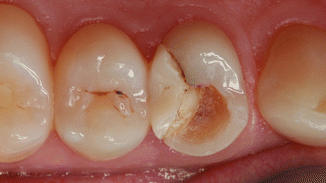


Fig. 8.3
Fracture of buccal cuspid of an upper premolar with deep decay underlying an old, fractured composite filling (Reprinted with permission from Olivi et al. [3])

Fig. 8.4
Before placing the rubber dam, the old filling is removed and the gross dentin decay is removed by Er:YAG laser; also a minimal marginal gingivectomy is performed in order to place the proximal margin above the gum (Reprinted with permission from Olivi et al. [3])
During laser cavity preparation, the complete caries removal is performed at 150 mJ or less, at 15–20 Hz, with short pulse duration (100–300 μ) and air/water spray on; the final decontamination of the dentin surface must be performed carefully to avoid damage to the pulp and performed at lower energies of 70–80 mJ at 10 Hz (100-μ pulse duration), in focused mode and with water spray. The seal of the deep dentin area close to the pulp, called also dentin melting, allows the prevention of postoperative sensitivity and is executed in a defocused mode at 25 mJ, 10 Hz, short pulse duration (100–300 μs), with air on to cool the operative field (no water or low air–water spray), for 5 to 10 s (Fig. 8.5); the application of a bioactive liner (calcium hydroxide, MTA, or Biodentine) and an immediate composite filling complete the procedure, allowing for an hermetic seal of the cavity (Figs. 8.6, 8.7, 8.8, 8.9, and 8.10).
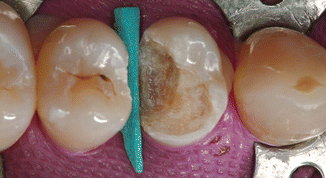
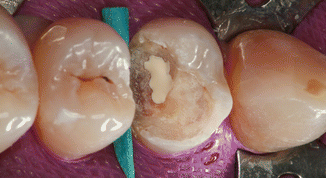
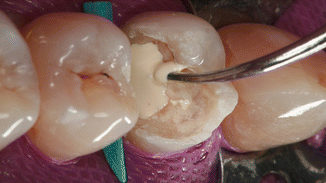

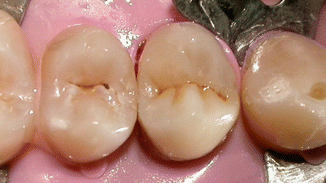
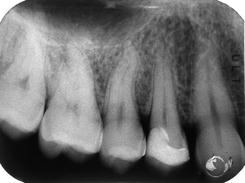

Fig. 8.5
Decontamination and final melting of the deep dentin surface is performed by Er:YAG laser at 25 mJ, 10 Hz (Reprinted with permission from Olivi et al. [3])

Fig. 8.6
A first layer of calcium hydroxide is applied as capping material (Reprinted with permission from Olivi et al. [3])

Fig. 8.7
A second layer of calcium hydroxide is applied after the hardening of the first one and then is burnished on the dentin to allow a better sealing (Reprinted with permission from Olivi et al. [3])

Fig. 8.8
Dentin immediate sealing and composite buildup guarantee an hermetic seal (Reprinted with permission from Olivi et al. [3])

Fig. 8.9
Indirect composite restoration is bonded (Reprinted with permission from Olivi et al. [3])

Fig. 8.10
The 1-year intraoral x-ray shows a good sealing and the absence of apical translucency (Reprinted with permission from Olivi et al. [3])
The final decontamination procedure, but not the caries vaporization, is also possible with all the other laser wavelengths used in dentistry (see Chap. 4).
If during the procedure a pulp exposure occurs, a laser direct pulp capping can be performed: if the diagnosis has been correct, the exposure is minimal, the surrounding area is clean and decontaminated, and the erbium laser makes also this procedure more predictable (Figs. 8.11, 8.12, 8.13, and 8.14).
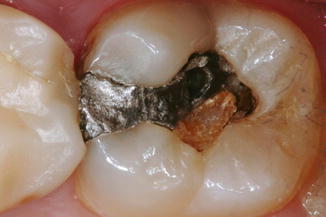
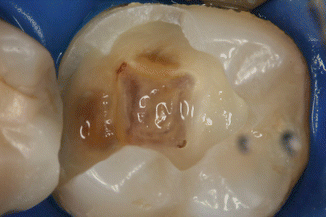
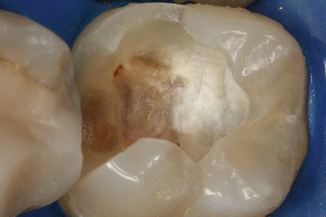
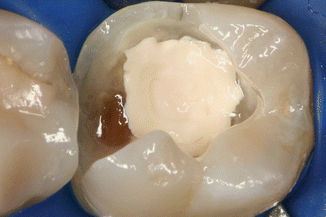

Fig. 8.11
Carious infiltration around old amalgam filling

Fig. 8.12
Filling and carious removal performed with high speed drill: after cleaning the bottom of the cavity with sodium hypochlorite, multiple micro pulp exposures occur; also visible is the roof of the chamber

Fig. 8.13
Er:YAG laser decontamination and conditioning; also partial melting is performed on deep dentin surface

Fig. 8.14
Pulp capping is performed with two layer of self hardening calcium hydroxide
If the choice is a stepwise technique, the operator, after an initial removal of the gross carious dentin mass using both a hand excavator and a laser, has to partially remove the inner caries layer, avoiding to dig deep the dentin surface, thus avoiding the pulp exposure; lower energy is required for carious tissue, and the operator has to check the better energy to use in a range of 150 mJ up to 100 mJ. After a final laser decontamination at 75 mJ, 10 Hz on the inner dentin layer, the application of a calcium hydroxide medication and an hermetic temporary sealing (glass ionomer cement or Biodentine) in order to stimulate the formation of reparative dentin complete the first session. After 4–6 months during the second session, the liner material must be carefully removed, and the underlying dentin must be checked with a probe and an excavator; then a final laser decontamination is performed before the final restoration. If at this stage a pulp exposure occurs, a root canal therapy has to be considered.
8.3 Direct Pulp Capping
Traditional definition of S. Cohen and R. C. Burns [43] described pulp capping as “the application of a medicament or dressing to the exposed pulp in an attempt to preserve vitality.”
Ingle’s [27] defined the direct pulp capping as “the protection of a pulp exposed for trauma to the anterior teeth, accidental mechanical exposure during tooth cavity preparation or deep dentinal decay.”
These definitions identify the indications for this therapy that are schematized in Table 8.2.
Table 8.2
Indication for direct pulp capping
|
Pathology
|
Time
|
Exposure size
|
Exposure site
|
Degree of bleeding
|
|---|---|---|---|---|
|
Recent dental trauma
|
24 h
|
~ 1 mm
|
Limited, red
|
|
|
Mechanical exposure during cavity preparation
|
Immediate filling
|
~ 1 mm
|
Occlusal
|
Limited, red
|
|
Exposure during deep caries excavationa
|
Immediate filling
|
~1 mm
|
Occlusal
|
Limited, red
|
A review of the international literature shows how the different success rates of the pulp-capping procedures are related to various clinical situations that led to the exposure. High success rate was found in the treatments performed for trauma to the anterior teeth [44–46] or accidently during mechanical preparation [47], all conditions with lower bacterial component than the posterior teeth treated for deep caries [2, 45].
Historically, direct pulp capping after exposure during caries excavation has been considered controversial, and instead, conventional endodontic therapy has been recommended in this case [47–49]; indeed, when bacterial by-products induce pulpal inflammation, compromise immune responses, and impede cellular differentiation and recruitment, normal pulpal repair mechanisms may not function properly.
The success of pulp capping basically depends on the proper diagnosis of reversible pulpitis before treatment [4, 50]; however, a definitive pulpal diagnosis is often difficult to establish [51].
8.3.1 Indication, Diagnosis, and Prognosis
Matsuo et al. analyzed the relationships between the success rates of pulp capping to carious exposed pulp and some clinical findings and found that the age of the patients, type of teeth, responses to thermal stimuli and percussion, and diameter of pulpal exposure had no influence on the success rate, while the degree of bleeding was indicative of the prognosis of this treatment. He found that the success rate of the study was 81.8 % and also estimated the length of time necessary for adequate postoperative follow-up to be 20–24 months [52].
Barthel et al. [11] determined other factors that might have an influence on the success rate of the therapy, such as the type of capping agent, type of restoration, and site of exposure.
They found that the placement of a definitive restoration within the first 2 days after pulp exposure is a factor of influence to contribute significantly to the survival rate. Results showed 44.5 % failures after 5 years and 79.7 % failing after 10 years [11].
Also Al-Hiyasat et al. determined that the success was associated more with mechanical exposure than with carious exposure (92.2 % versus 33.3 %). Permanent restoration had a better outcome than temporary restoration (80.8 % versus 47.3 %) and more with class 1 occlusal restoration (83.8 %) than with proximal multiple surface restorations (class 2, 56.1 %; class 3, 58.8 %; mesial-occlusal-distal restoration, 28.6 %) [49].
It is possible to summarize the contraindications for pulp capping in carious teeth, when the following preoperatory symptoms and intraoperatory signs are present:
-
Preoperatory symptoms
-
Decay associated to a recent or past history of spontaneous or recurrent or nocturnal pain
-
Thickening of the periodontal ligament at the level of the apex observed radiographically
-
-
Intraoperatory signs
-
Extensive pulp exposure (>1 mm diameter)
-
Inflamed or necrotic appearance of pulp tissue at microscopic observation (Figs. 8.15, 8.16, 8.17, and 8.18)
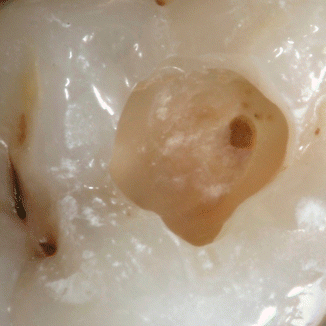 Fig. 8.15Upper molar shows minimal occlusal pulp exposure; the pulp is not visible, probably pulled back for a chronic inflammation process. Pulp capping is not advisable
Fig. 8.15Upper molar shows minimal occlusal pulp exposure; the pulp is not visible, probably pulled back for a chronic inflammation process. Pulp capping is not advisable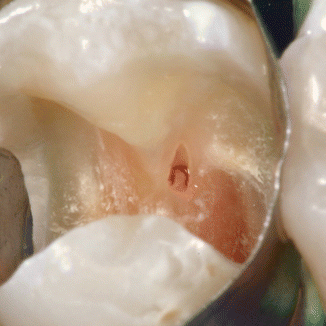 Fig. 8.16Upper premolar shows occlusal pulp exposure; the appearance of the pulp tissue is vital, no bleeding
Fig. 8.16Upper premolar shows occlusal pulp exposure; the appearance of the pulp tissue is vital, no bleeding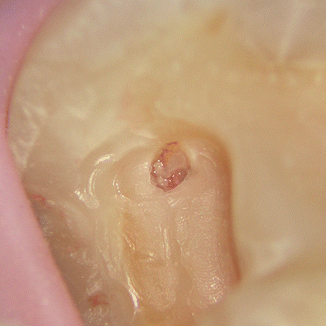 Fig. 8.17Accidental pulp exposure during inlay cavity preparation with mechanical instruments in an upper molar; the pulp appears vital, with no bleeding
Fig. 8.17Accidental pulp exposure during inlay cavity preparation with mechanical instruments in an upper molar; the pulp appears vital, with no bleeding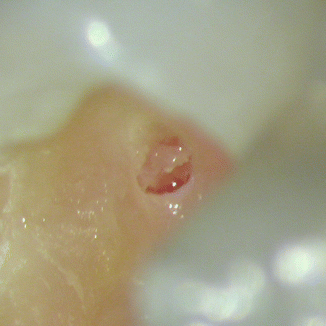 Fig. 8.18Upper molar with occlusal pulp exposure: note the clear color of predentin around the pulp exposure. The pulp appears vital with no bleeding
Fig. 8.18Upper molar with occlusal pulp exposure: note the clear color of predentin around the pulp exposure. The pulp appears vital with no bleeding -
Abundant bleeding after exposure which does not resolve after 1–2 min that confirms the inflamed status of irreversible pulpitis
-
Site of the exposure on the axial wall of proximal decay that may be a concern because of the large extent of pulp tissue involved in the inflammation
-
In these instances, even partial pulpotomy must be carefully considered.
Table 8.3 reports clinical contraindications for pulp-capping procedures in permanent carious teeth.
Table 8.3
Contraindication for pulp capping in carious teeth
|
Preoperatory symptoms
|
Decay associated to pain
|
|
Thickening of the periodontal ligament at the level of the apex at x-ray
|
|
|
Intraoperatory signs
|
Extensive pulp exposure (>1 mm diameter)
|
|
Inflamed or necrotic appearance of pulp tissue
|
|
|
Abundant bleeding after exposure which does not resolve after 1–2 min
|
|
|
Site of the exposure on the axial wall of proximal decay
|
Diagnostic tests and examinations to establish a correct diagnosis and outcome are:
-
Objective examination; intraoral examination (color, tumor), evidence of lack of mobility, and pain at percussion are also important diagnostic elements.
-
Intraoral radiographic examination to assess the degree of the pulp exposure and verify the absence of a thickened periodontal ligament at the apex.
-
Electrical and thermal tests (cold and hot).
Also a laser Doppler flowmeter (LDF) has been studied in recent years and found very effective in detecting the revascularization of damaged pulps following traumatic injury or dental caries, compared to other procedures such as electric pulp testing [53–55].
In case of dental trauma, beside the other diagnostic data, the decision path on the treatment plan to be followed includes the time between trauma and therapy, the size of pulpal exposure, the type of bleeding, and the appearance of the pulp to a microscopic examination (Figs. 8.19, 8.20, 8.21, and 8.22). Table 8.4 reports the indications for pulp therapy in case of complicated dental trauma.
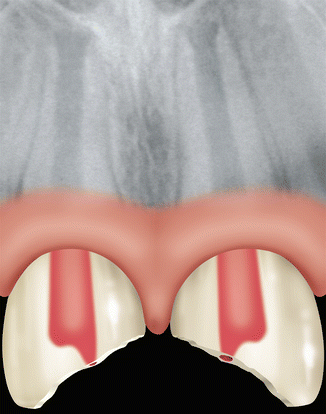
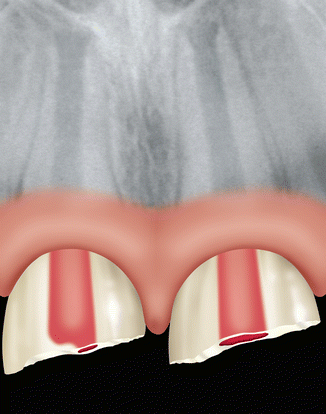
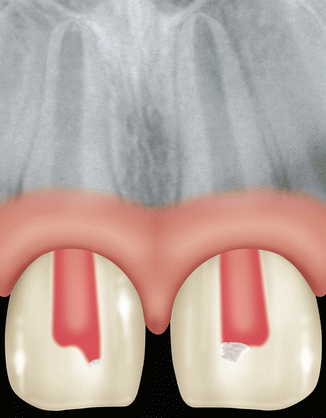


Fig. 8.19
Diagram of small pulp exposure (1 mm) in upper incisors for complicated dental trauma

Fig. 8.20
Diagram of larger pulp exposure (1 > 2 mm) in upper incisors for complicated dental trauma

Fig. 8.21
Diagram of pulp capping in upper incisors for complicated dental trauma

Fig. 8.22
Diagram showing root maturation after pulp therapy for complicated dental trauma (Reprinted with permission from Olivi et al. [4])
Table 8.4
Pulp therapy in complicated dental trauma
|
Pulp capping
|
Pulpotomy
|
Pulpectomy
|
||
|---|---|---|---|---|
|
Exposure size
|
Smaller
<1 mm
|
Smaller
<1 mm
|
Larger
>1 mm
|
Small or large
|
|
Time between
trauma and therapy
|
Within 24 h
|
Within 48–72 h
|
>72 h
|
|
|
Quality of bleeding
Pulp appearance
|
Serum, bloody, red color
Pink color
|
Bloody, red color
Red color
|
Bloody, dark red color, pus
Gray color
|
|
|
Symptoms
|
None
|
None
|
Painful (pulpitis)
None (necrosis)
Tumor (abscess)
|
|
8.3.2 Laser for Operative Field Control
Among the innovative techniques proposed to halt the carious process and promote the repair of potentially damaged tissue, the use of laser has proved to be highly effective, thus improving the survival rates when compared to the conventional techniques [1, 2, 56–64].
If a correct diagnosis is performed and the pulp is affected by a hyperemia or a reversible pulpitis, the positive effects of the laser irradiation can create the biological base for the development of the healing process, conditioning the operatory field through a deep decontamination and an effective coagulation; finally, a pulp-capping material can promote the formation of a dentinal bridge. An immediate filling is a mandatory condition to maintain these conditions.
Laser-assisted pulp capping (LAPC) decontaminates the exposed area, superficially or more in depth, depending on the wavelength used and coagulates the pulp, leaving a dry site very suitable for a capping material; according to Matsuo et al., a good hemostasis increases the success rate of the procedure [52] (Figs. 8.23, 8.24, 8.25, and 8.26).
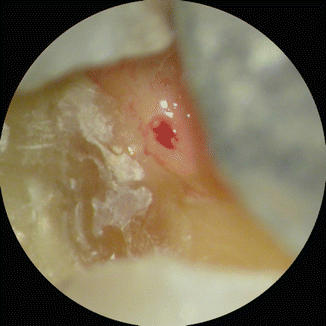
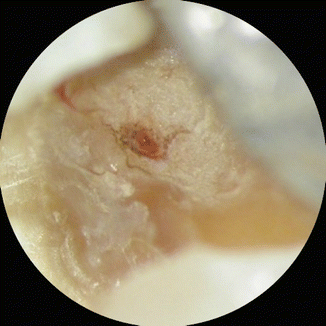
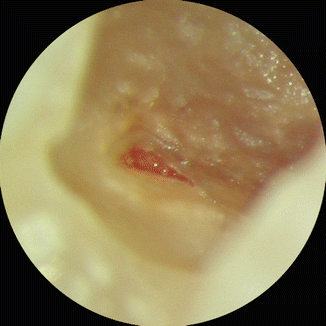
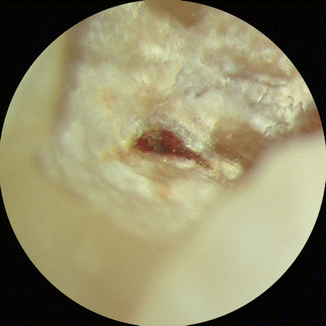

Fig. 8.23
Pulp exposure for deep decay after cavity preparation (Reprinted with permission from Olivi et al. [4])

Fig. 8.24
Er:YAG laser coagulation with a 600-μm tip for 5–6 s at 30 mJ and 3 Hz in defocused mode with air cooling but no water (original magnification ×40)

Fig. 8.25
Upper molar shows a pulp exposure for deep decay at the end of cavity preparation

Fig. 8.26
Er,Cr:YSGG laser coagulation with a 600-μm tip, at 25 mJ, 10 Hz, water off
Moreover, the irradiated and coagulated pulp presents an amorphous necrotic superficial layer that avoids any direct contact of whatever capping material with underlying vital pulp, making the choice for the liner wider.
When erbium chromium or erbium lasers are used for the complete procedure including the cavity preparation, the other advantages of the erbium laser [4, 39, 40] are the reduced heating in the pulp during the cavity preparation [65, 66] and the reduced intra-chamber pressure during the vaporization of deep carious dentin layers that leads to a reduced possibility of accidental misplacement of infected chips in the pulp chamber [2, 27].
When erbium lasers are not available and only the near-infrared (diode and Nd:YAG) and infrared (CO2) lasers can be used, the cavity is prepared with conventional mechanical technique, and these lasers allow only decontamination of the cavity and coagulation of the exposed pulp.
According to other studies [11, 49], an hermetic seal of the pulp exposure and an immediate permanent filling after the pulp capping allow for a superior success rate; an hermetic pulp–dentin interface seal ensures the maintenance of the decontamination and, at the same time, stimulates the formation of tertiary dentin which will enhance the healing of the treated tooth.
Clinicians have used many materials for direct pulp capping, including calcium hydroxide, hydrophilic resins, resin-modified glass ionomer cements, and, more recently, mineral trioxide aggregate (MTA) and tricalcium silicates (BiodentineTM).
8.3.3 Pulp-Capping Agents
8.3.3.1 Calcium Hydroxide
Calcium hydroxide (CH) has been used for many years for pulp-capping procedures [67]. Long-term studies on the use of calcium hydroxide-based preparations (nonhardening suspensions and hardening cements) have shown variable results that are somewhat unpredictable [11, 46, 51, 68]. The fact that the material does not provide close adaptation to dentin can result in limited odontoblast differentiation and reparative dentin formation within dentin bridges, characterized by tunnel defects [69–71]; tunnel defects may provide a pathway for the penetration of microorganisms that induce pulpal irritation and produce subsequent dystrophic calcification [70]. Although calcium hydroxide does not have the ability to properly seal the pulpal site, it has been used in one-visit tooth restoration when used in combination with amalgam or adhesive composite materials for an immediate sealing [4]. On the other hand, a scanning electron microscopic ultrastructural study by Goracci and Mori evaluated the resin–dentin and calcium hydroxide–dentin interface with resin composite restorations and indicated that polymerization shrinkage of the resin composite caused the separation of the calcium hydroxide from the dentinal surface, forming 8- up to 15-μm-wide interfacial gaps in 100 % of the areas studied. This finding confirmed that pulpal inflammation after calcium hydroxide use may be associated to the microleakage of restorations and to the subsequent transit of bacteria [72]. Accordingly, the research has been directed toward materials which are much more adherent to dentin and stable over time.
8.3.3.2 Adhesive Systems and Glass Ionomer Cement
8.3.3.3 Mineral Trioxide Aggregate
Mineral trioxide aggregate (MTA) is a bioactive silicate cement that has been shown to be an effective pulp-capping material in nonhuman models and human in vivo studies [78–80]. The small particle size, the sealing ability, the alkaline pH when set, and the slow release of calcium ions are all favorable factors for pulp capping [81]. Numerous studies demonstrated the absence of cytotoxicity of the MTA when in contact with fibroblast and osteoblast cultures [82] as well as the stimulation of dentin bridge formation when used for direct pulp capping [81, 83].
If compared to the use of CH, the application of MTA ensures a more hermetic and lasting seal and therefore the formation of a more compact and thicker dentin bridge that do not include fibrotic tissue. Negative factor is that MTA requires a longer time to harden and the completion of the restoration requires a second session after 48–72 h that can be a problem in case of esthetic restorations in anterior teeth.
Stay updated, free dental videos. Join our Telegram channel

VIDEdental - Online dental courses


